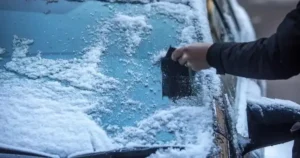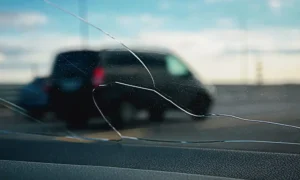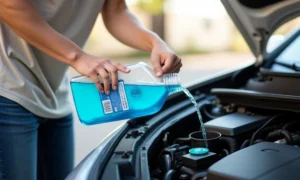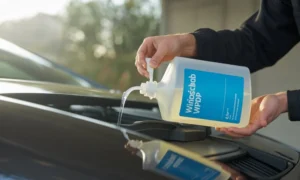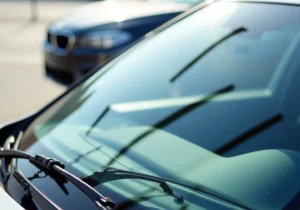Different types of auto window tint not only enhance the look of your car but also serve important functions like protecting you from UV rays, reducing heat, and improving privacy. Whether you’re considering a subtle tint or something more advanced, it’s important to know the different window tints available and how they perform under real-world conditions. In this guide, you’ll learn about the different types of auto window tint, what makes each one unique, and how to choose the best option based on your needs, budget, and lifestyle. We’ll also touch on key factors like local laws and tinting regulations specific to Austin, Texas, so you stay safe and compliant on the road.
What is Car Window Tinting?

Applying a thin, translucent substance known as window film to the inside of your automobile’s windows is known as car window tinting. This film can be clear or dark, depending on the types of window tint you choose. It’s a simple upgrade that brings multiple benefits for both your car’s comfort and safety.
Why Do People Tint Car Windows?
Here’s what car window tinting does:
- Heat Rejection: Tinted windows help keep your car cooler by blocking out the sun’s heat. This means less need for AC and more comfortable drives, especially in hot climates like Texas.
- UV Protection: The window film blocks up to 99% of harmful UV rays. This protects your skin and also prevents your car’s interior from fading or cracking over time.
- Privacy: By making it more difficult for others to see inside your automobile, tinted windows increase your privacy. Some options, like privacy glass, are darker and commonly used on rear windows.
- Glare Reduction: When driving, sun glare might be harmful. Tinted windows reduce glare, helping you see the road clearly without squinting.
- Safety: The tint film keeps the shattered glass together in the event of an accident, keeping potentially harmful fragments from flying into the vehicle.
Different Types of Tint You Can Choose From
There are different types of tint available, each offering a unique level of performance and appearance. Common options include:
- Dyed Window Film: Good for basic privacy and reasonably priced.
- Metalized Film: uses metal particles to block heat, but it may disrupt phone and GPS signals.
- Carbon Tint: Offers excellent heat reduction without signal issues.
- Ceramic Tint: Premium option that blocks the most heat and UV rays while staying clear and signal-friendly.
Different Types of Auto Window Tint
When choosing the right tint for your vehicle, it’s important to understand the different types of tint available. Each type offers unique benefits in terms of cost, performance, and appearance. Below, we break down the different types of auto window tint so you can make the best choice for your needs.
4.1 Dyed Window Tint
The least expensive of the several tint options is dyed window tint. It is created by sandwiching a layer of dye between a protective top coating and an adhesive layer.
- Reduces glare and improves driving visibility
- Adds privacy by darkening the windows
- Budget-friendly choice
- Over time, it may fade or discolor with sun exposure
Best for: Drivers looking for a low-cost solution with decent privacy and glare reduction.
4.2 Metalized Window Tint
This kind blocks heat and reflects sunlight using metallic particles inserted in the film. It’s more durable than dyed tints.
- Offers excellent heat rejection
- Adds strength to windows (helps prevent shattering)
- Strong and long-lasting
- May cause interference with GPS, phone, and radio signals
Best for: Drivers who want long-lasting tint with strong performance—but don’t rely heavily on electronic devices.
4.3 Carbon Window Tint
Carbon tint has a non-reflective finish and contains carbon particles that block both infrared light and UV rays.
- Keeps the car cooler by reducing heat buildup
- Prevents interior fading due to UV exposure
- Stylish matte look
- No signal issues
Best for: Those who want better thermal insulation without signal interference.
4.4 Ceramic Window Tint
Ceramic is the highest-performing option among all the different types of tint. It contains non-metallic, non-conductive ceramic particles.
- Blocks 99% of UV rays and most heat and infrared rays
- Maintains clear visibility, even at night
- No interference with electronics or signals
- Superior durability and clarity
Best for: Car owners looking for the best protection, comfort, and appearance—worth the premium price.
4.5 Hybrid Tint (Dyed + Metalized)
Hybrid tint combines dyed and metalized layers to offer a balanced performance between the two.
- Moderate heat and UV protection
- Less fading than dyed-only tints
- Fewer signal issues than full metalized versions
- Cost-effective with improved durability
Best for: Those who want a mid-range tint with better performance than dyed film but less risk of interference than full metalized options.
You can also read about How Much Does It Cost To Tint A Sunroof.
Factors to Consider When Choosing Car Window Tint

Before picking the right tint for your car, it’s important to consider a few key factors. With so many different window tints available, your choice should depend on your needs, vehicle type, and driving habits. Let’s break down what to keep in mind when comparing different types of auto window tint.
Budget: Affordable vs. Premium Films
Your budget will play a big role in the tint you choose. Some different window tints, like dyed film, are low-cost and great for basic privacy. On the other hand, premium options like ceramic tint offer top-tier heat rejection and clarity but come at a higher price. Think about what you’re willing to spend based on how long you plan to keep the vehicle and your comfort needs.
Privacy Needs: Tint Levels for Visibility
All different types of auto window tint offer varying levels of privacy. Darker tints block more visibility from the outside, which is ideal for those who value privacy while driving or parked. However, you’ll need to stay within local tint laws to avoid fines. If privacy is your priority, options like carbon tint or privacy glass offer a good balance.
Heat Rejection & UV Protection: Especially in Texas
If you’re driving in a hot climate like Texas, heat rejection and UV protection should be a top priority. Some different window tints, such as ceramic and carbon, block out infrared and UV rays effectively—keeping your cabin cooler and protecting your interior. This helps reduce AC use and increases long-term comfort.
Aesthetic Preference: Shade and Finish
Window tint isn’t just functional—it changes the look of your car too. Some drivers prefer a matte finish (like carbon tint), while others may want a reflective or glossy look (like metalized tints). The different types of auto window tint give you a range of visual styles to choose from, so pick one that matches your vehicle’s look and your personal style.
Signal Interference Concerns: For Tech-Savvy Drivers
Some tints, especially metalized films, can block or interfere with GPS, Bluetooth, or cellular signals. If you rely on tech devices in your car—like navigation, streaming, or hands-free calling—it’s better to choose a non-metal film like ceramic or carbon, which don’t affect connectivity.
Vehicle Type and Use: Personal vs. Commercial
The best tint also depends on your vehicle type. A commercial van may need darker, privacy-focused tint to protect cargo, while a personal vehicle might benefit more from comfort and UV-blocking features. Each different type of auto window tint brings different strengths, so think about how you use your car day-to-day.
You can read about How To Repair Window Tint Bubbles.
Window Tinting Regulations in Austin, Texas
Before applying any window film to your vehicle, it’s important to understand the window tinting regulations in Austin, Texas. These laws are in place to ensure safety and visibility while still allowing for heat and UV protection. Below is a simple breakdown of what’s legal, what’s not, and what exceptions exist under the Texas Transportation Code.
Legal Tint Limits in Texas
Windshield:
- Tint allowed only above the AS-1 line (or top 5 inches).
- Tint must be non-reflective.
Front Side Windows:
- Must allow 25% or more of visible light through (VLT 25%).
- Reflectivity cannot exceed 25%.
Back Side Windows:
- Any tint darkness is allowed.
- No VLT requirement, but vehicle must have dual side mirrors if back windows are tinted.
Rear Window:
- Any darkness is allowed if dual side mirrors are installed.
- No restriction on reflectivity for rear windows.
These percentages refer to the Visible Light Transmission (VLT) — how much light must pass through the window. When choosing between different window tints, ensure the film matches these standards.
Texas Transportation Code Compliance
Under Texas Transportation Code § 547.613, all aftermarket window tint installations must follow these rules:
- A compliance label must be affixed to the driver’s side window.
- The label must include the installer’s company name and confirm the tint meets legal standards.
- Window tint film must be certified for use in Texas.
Always ask your installer if the film is Texas-legal and ensure they provide the correct compliance documentation.
Penalties for Illegal Tint
If your vehicle’s tint doesn’t comply with state laws, you could face:
- Fines up to $200
- A ticket for equipment violation
- Failing your annual vehicle inspection
- A requirement to remove or replace the illegal tint
Law enforcement may use a tint meter during stops to check if your film meets the VLT requirement.
Final Thoughts
Choosing the right window tint depends on your needs and budget. Dyed tint is great for affordability, while ceramic offers top-tier heat and UV protection. Carbon provides a balance of performance and appearance, and hybrid tints offer mid-range benefits. Avoid metalized films if you rely on GPS or Bluetooth. Not sure which to pick? Contact Texas Reliable Auto Glass for expert guidance and professional installation. Call us today to find the perfect tint for your vehicle!
FAQs
What Are The Most Common Types Of Auto Window Tint?
The most common types include dyed, metalized, carbon, ceramic, and hybrid (dyed + metalized) tints. Each offers varying levels of privacy, UV protection, heat rejection, and durability.
Which Window Tint Is Best For Blocking Heat?
Ceramic tint offers the highest heat and UV rejection. It’s ideal for hot climates like Texas and helps keep your car cool without signal interference.
Does Metalized Tint Affect My Phone Or Gps Signal?
Yes, metalized tint may interfere with electronic signals such as GPS, cell service, and radio. For tech-heavy users, carbon or ceramic tints are better options.
Is Dyed Window Tint A Good Option?
Dyed tint is budget-friendly and reduces glare but tends to fade over time and offers less heat rejection than premium options.
What Is A Hybrid Window Tint?
Hybrid tint combines dyed and metalized layers to provide a balance of cost, performance, and durability with reduced signal interference.


